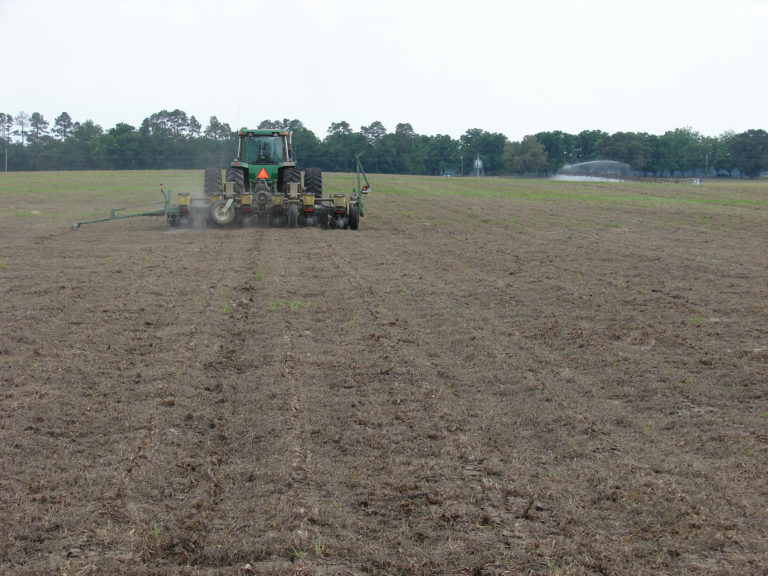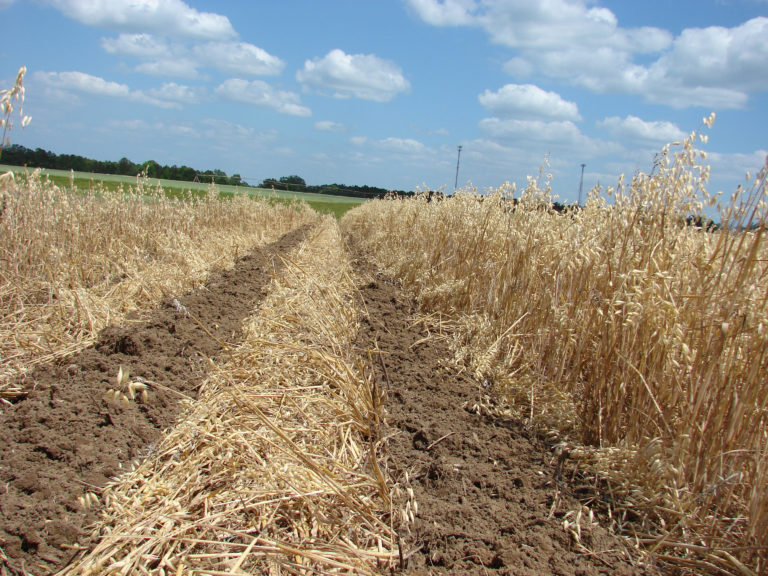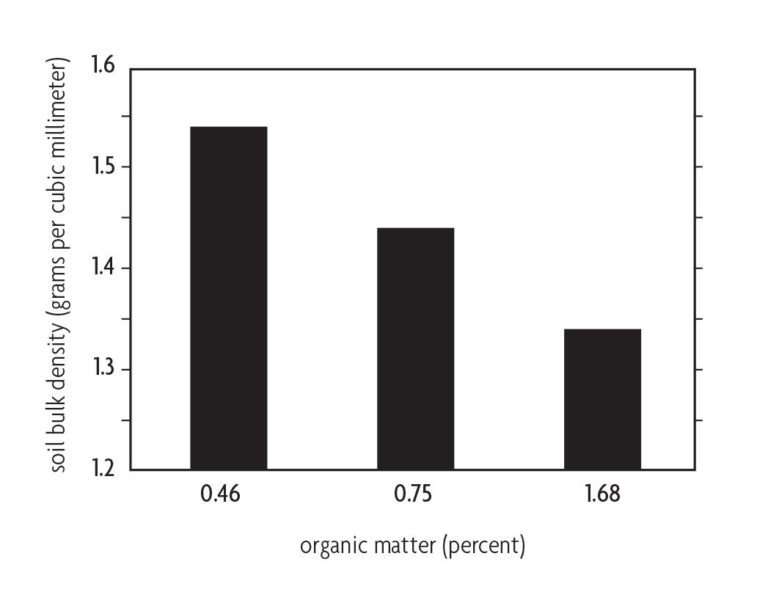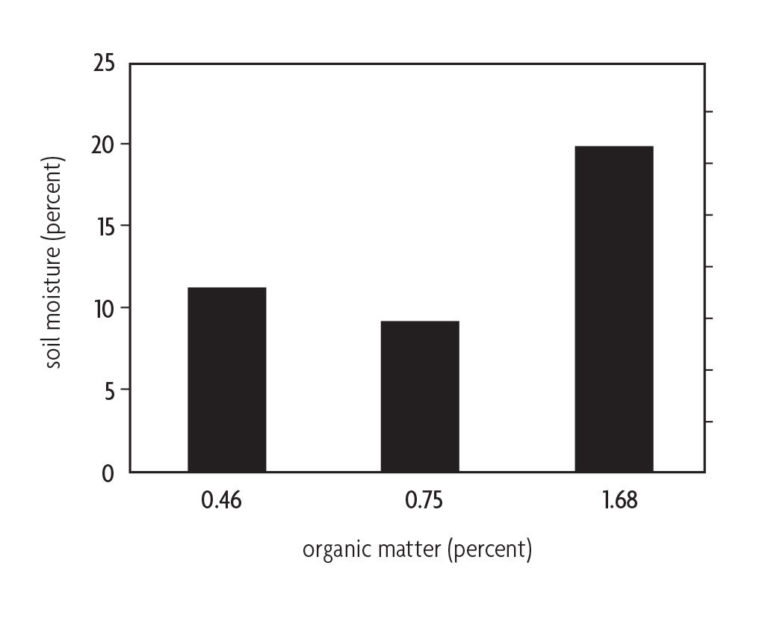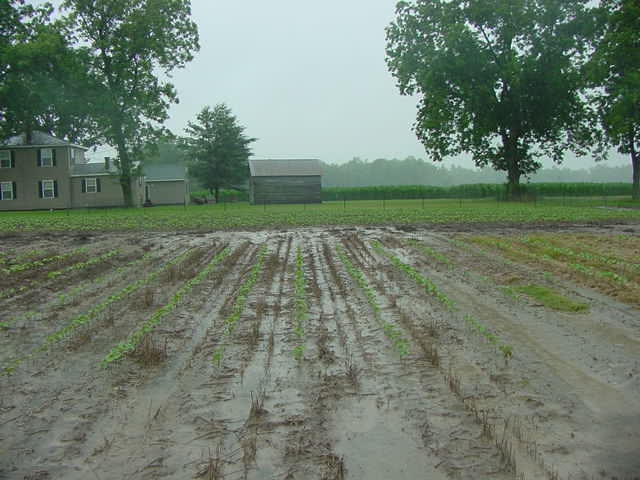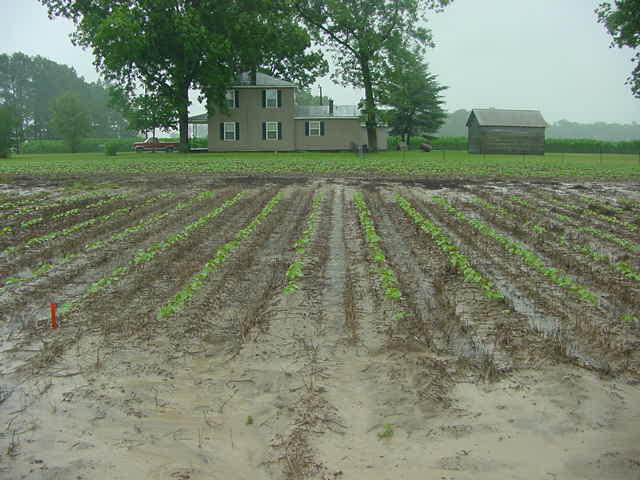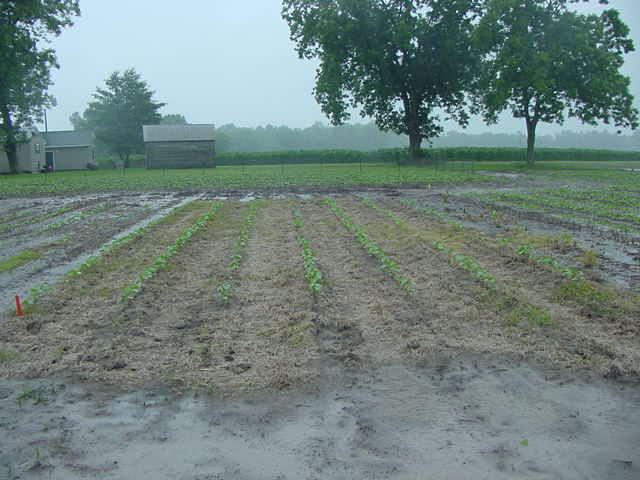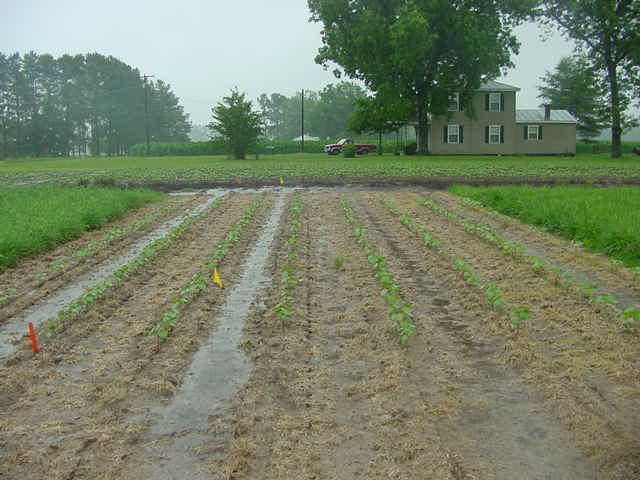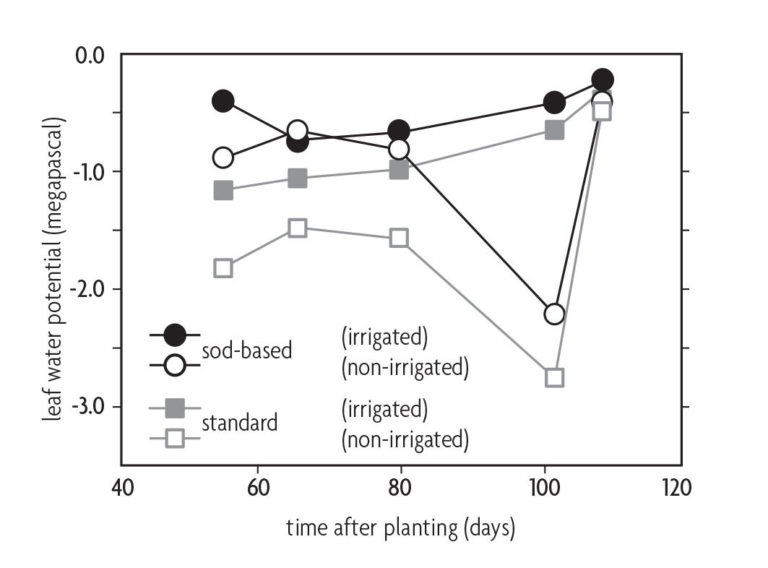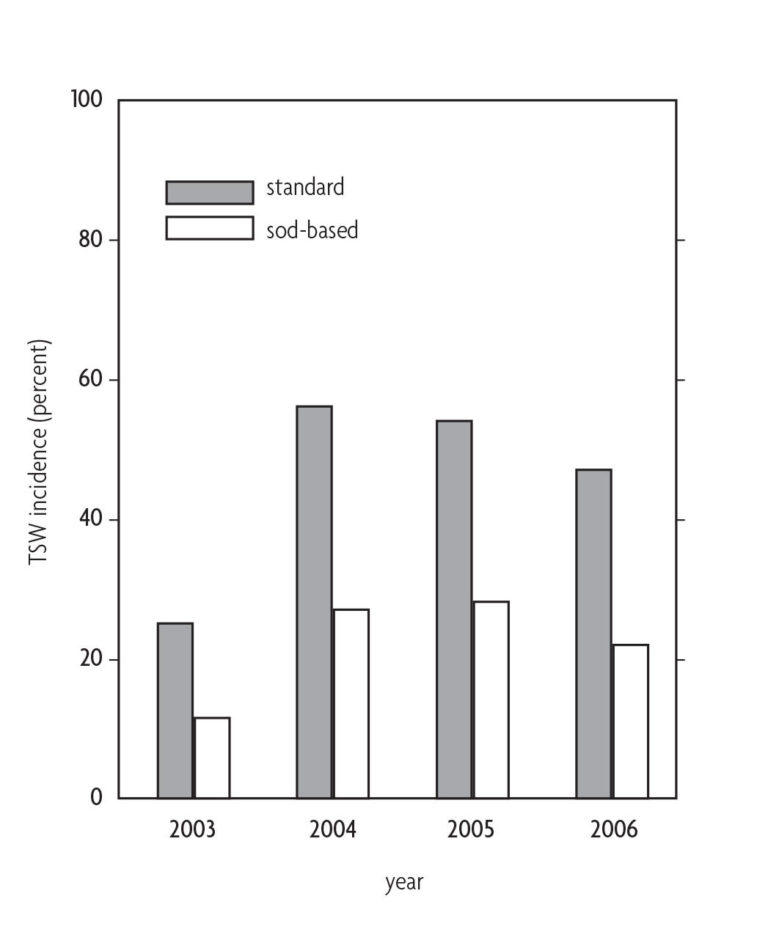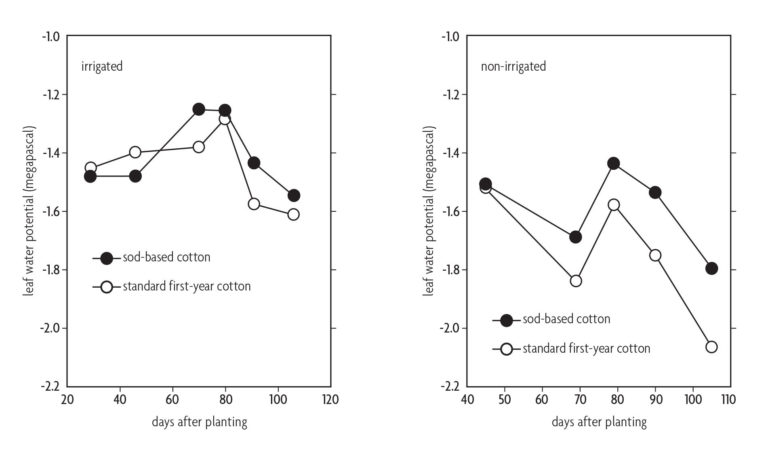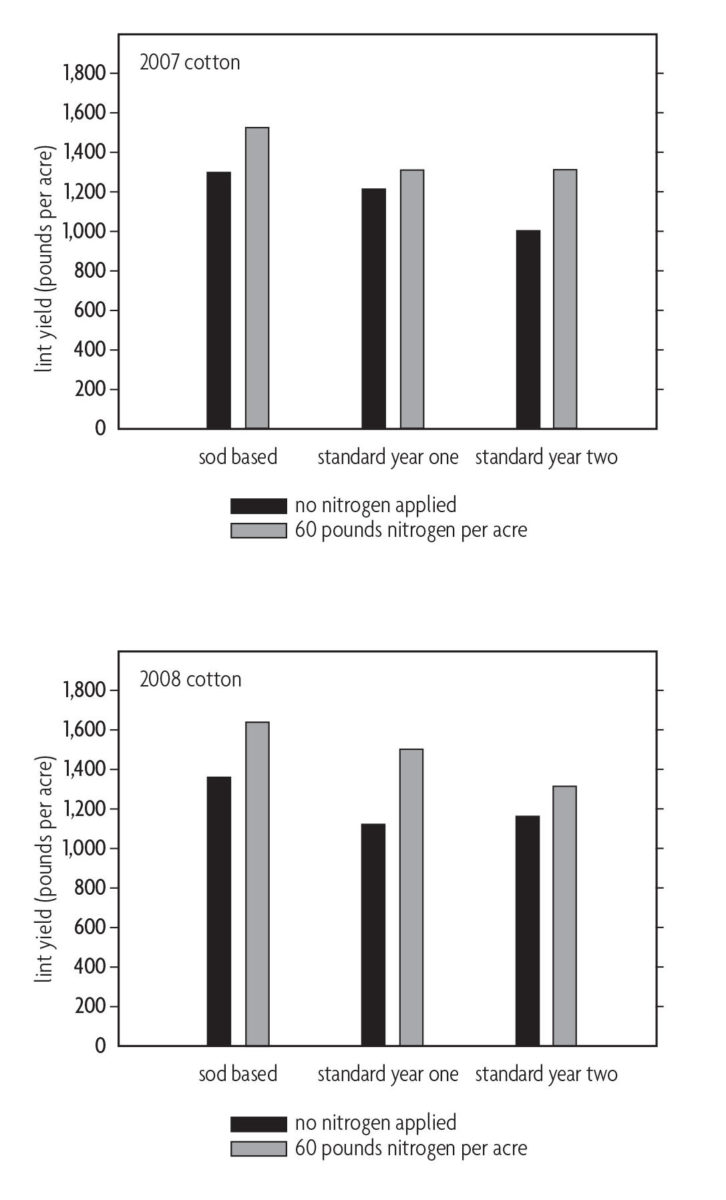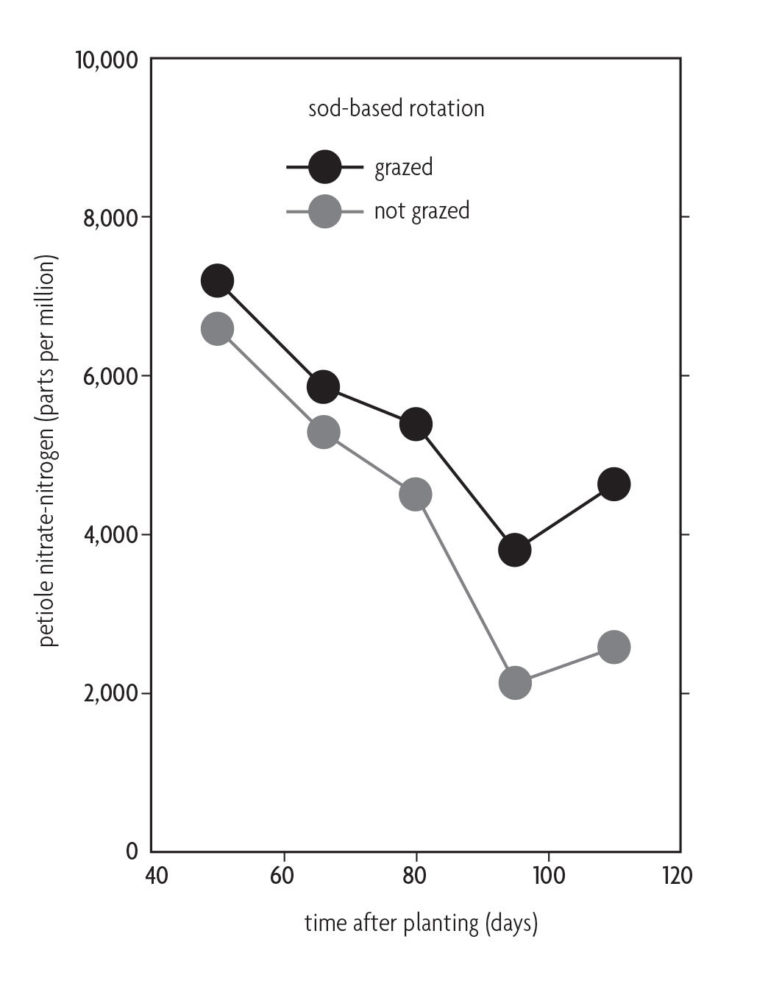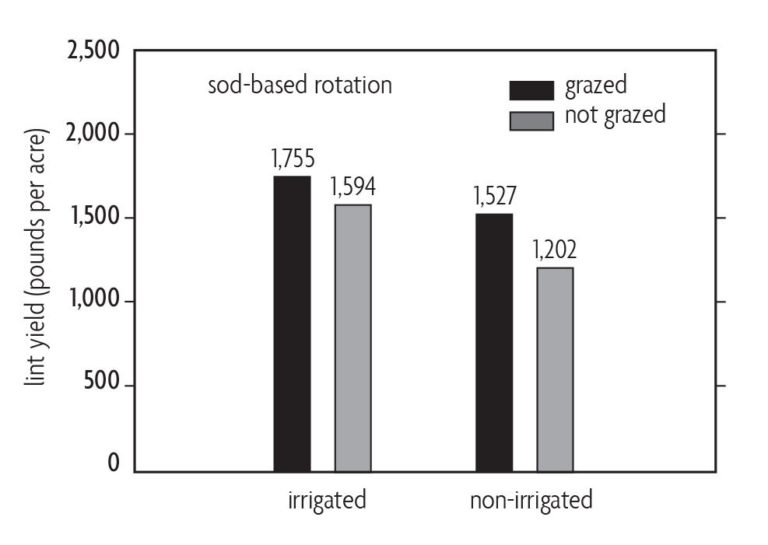Growing bahiagrass for two years prior to growing row crops in a conservation tillage system has numerous economic and environmental advantages over standard conservation practices. The chemical and physical properties of the soil are improved. Crop yields increase, pest pressure decreases, and the need for fertilizer, pesticides and irrigation decreases. This section reviews the benefits of a sod-based rotation to the soil, peanut production and cotton production [16, 21, 24, 25, 47].
Soil Benefits
The biggest benefit of adding sod to a standard conservation rotation is improved soil quality [35]. Adding bahiagrass and livestock grazing to the standard rotation helps sequester carbon, which increases soil organic matter. In the Southeast, it is estimated that pasture-based rotations with row crops and conservation practices could sequester 13–29 percent of the carbon potential in the United States (132–298 million metric tons of carbon or 145–328 million tons) [13].
Perennial grasses sequester more carbon and increase soil organic matter more than annual winter cover crops. Roots have a greater influence on soil organic matter than the aboveground plant biomass [31, 34, 43]. For example, corn roots contribute 1.6 times more carbon to soil organic matter than stover [2]. When the carbon from root exudates, mucilages, sloughed cells and roots are considered, corn root biomass contributed between 1.7–3.5 times more carbon to the soil than stover [1]. A perennial grass like bahiagrass provides about 8.5 tons of biomass per acre [5] compared to 1.3–1.8 tons per acre from a small-grain cover crop. Adding sod to a standard conservation rotation can increase soil organic-matter content up to 0.8 percent over a nine-year period.
Figure 8.2a shows the seedbed prepared in a perennial grass system, and Figure 8.2b shows the seedbed prepared in a system using annual winter cover crops. In each case the seedbed was prepared using a ripper, a type of in-row subsoiling. The root mass in the perennial system is about 20,000 pounds per acre while the root mass in the annual winter cover crop system is 3,000–4,000 pounds per acre. With the greater root mass, ripping results in a narrower tilled area compared to the tilled area in the annual winter cover crop system. The narrow-tilled area is preferred because more of the soil surface is covered with residue.
Perennial grass in a row-crop rotation also has a positive impact on earthworm populations. Earthworms aid in rooting of subsequent crops, reduce nutrient losses to the environment by 40–60 percent [27, 28, 29] and reduce soil erosion. At a research site in Quincy, Fla., the number of earthworms per acre was 7.5 times greater after a sod-based rotation as compared to a short-term rotation.
Soils with higher organic matter hold more moisture and experience less compaction from livestock grazing and planting and harvesting equipment (Figure 8.3). Compaction results in an increased bulk density and is a function of soil texture, soil moisture, grazing intensity, equipment traffic, vegetation and climate [39]. The risk of compaction is greatest as the soil begins to drain after being totally saturated. To minimize compaction, remove livestock from the field if there is standing water or saturated soil. Keep the livestock out of the field until excess moisture drains away and the soil can be worked (drier than field capacity). For sandy soils, this might be only one-half to one day. For clayey soils, this could take four to five days.
Studies of grazing in row-crop systems in Alabama observed compaction to a depth of 4–6 inches, but strip tillage eliminated the problem [37]. In general, livestock grazing affects soil compaction mostly in the top 6 inches of soil [45]. Systems with bahiagrass can limit that compaction to the top 2 inches due to the greater root mass and general improvements in soil structure that result from a sod-based rotation.
Perennial grasses grow under conditions that are less than ideal for many agronomic crops and are often planted in fields degraded by poor cropping practices. The grasses prevent erosion and rejuvenate “worn out,” low-fertility soils even under droughty or excess moisture conditions. Several perennial grasses are used in the Southeast for forage and grazing as well as for reclamation. In the Southeast, fescue is the dominant cool-season grass for pasture, while bahiagrass is the dominant warm-season grass [46]. Bahiagrass is a good choice for a sod-based rotation because it grows on all soil types found in the Southeast and is drought tolerant [18].
Coastal Plain soils have a natural compaction layer 6–8 inches deep [11, 22]. Bahiagrass roots will penetrate this layer, leaving root channels for crop roots to follow [16, 25, 47]. The porosity in the dense soil layer below the plow depth was evaluated for cotton following three years of continuous bahiagrass and for continuous cotton with winter cover crops. With the bahiagrass, there were seven times more pores greater than 0.04 inch [30]. This allows the cash crop to exploit a larger volume of soil for moisture and nutrients. Corn, soybeans, peanuts and cotton produce the most root growth in the first 50–60 days after planting. Any conditions that limit root development during this time, including compacted soil, slow plant growth.
The increased rooting depth following bahiagrass decreases irrigation needs. For the average Coastal Plain soil, a crop with a rooting depth of 12 inches will experience 60 drought days from May through August in five out of 10 years [16]. However, if the rooting depth were 60 inches, the crop would experience only 11 drought days. If the plant rooting depth is only 6 inches, which is the soil above the normal dense layer that occurs in Coastal Plain soils, plants will experience water stress after only three days without rainfall. By increasing rooting depth to 60 inches, the plant would not experience water stress until 30 days without rainfall [16] (Table 8.1).
Other perennial grasses have similar effects. Figure 8.4 compares infiltration after peanuts on four fields with four different rotations. The pictures were taken at the same time. Field A used a short-term rotation. Field B used a soybean>cotton>cotton>peanut rotation with winter cover crops. Field C had two years of continuous fescue prior to cotton and peanuts for a fescue>fescue>cotton>winter cover>peanut >winter cover rotation. Field D had two years of continuous orchard grass prior to cotton and peanuts for an orchard grass>orchard grass>cotton>winter cover>peanut>winter cover rotation. There is less standing water on the two fields that included two years of perennial grass in the rotation (fields C and D).
Increased water demand and droughts in the Southeast have increased the need for water conservation. Capturing more water through improved infiltration and increased rooting depth will reduce irrigation water demand by the agricultural community.
Peanut Production Benefits
Sod-based rotations typically increase peanut yields by 15–30 percent, resulting in more profit than could be expected in a standard conservation rotation. Typical peanut yields in the region using standard conservation or short-term rotations are 3,000–4,000 pounds per acre. Growers have experienced yield gains of 1,500–2,000 pounds per acre as well as significant disease reduction when growing peanuts following two years of bahiagrass. Research has shown that even one year of bahiagrass could increase peanut yield significantly [15, 32, 44]. More years in bahiagrass had a positive impact on peanut yield [21]. This yield benefit lasted only two years after bahiagrass. Then, yields were similar to continuous peanuts with winter cover crops [8]. Overall, the big selling point for having peanuts in the sod-based rotation is increased yield and profit potential for peanuts, along with income from livestock grazing and cotton.
The increase in peanut yield after bahiagrass may be the result of nematode reduction and increased rooting depth [8, 16]. One study showed reduced population densities of the root-knot nematode (M. arenaria) in peanuts early in the growing season following one year of bahiagrass. However, the nematode population increased to high levels at the end of the season [15].
As compared to the standard conservation rotation, peanuts had more extensive root systems and less plant stress following two years of bahiagrass in 2007, one of the driest years on record. After 80 days of peanuts following bahiagrass without irrigation, plant stress measured as leaf water potential was not significantly different from that of irrigated, standard conservation rotation peanuts (Figure 8.5). As leaf water potential becomes more negative, it is harder for plants to get water from soil. No aflatoxin was observed on either irrigated or non-irrigated peanuts following bahiagrass, while high levels of aflatoxin were found in the standard rotation non-irrigated peanuts planted into oat cover crops. Aflatoxins are naturally occurring fungal toxins produced by Aspergillus flavus and Aspergillus parasiticus. These toxins cause serious liver dysfunction in humans and animals. Peanuts are extremely susceptible to infection by these species, and aflatoxin control is critical since contaminated peanuts have no market value.
Perennial grasses are more effective in controlling soil-borne diseases in peanuts than in cotton [36, 41]. Tomato spotted wilt incidence was 50 percent less when peanuts were strip-tilled into bahiagrass as opposed to a winter cover crop [42] (Figure 8.6). The sod rotation in this study was cotton>bahiagrass>bahiagrass>peanuts with winter covers. Likewise, diseases such as leaf spot are delayed and have lower severity in a bahiagrass rotation as compared to standard conservation rotations [7, 42].
Peanuts planted into terminated bahiagrass that has been grazed tend to have slightly lower yields in some years than peanuts planted into bahiagrass that was not grazed. There was more surface compaction in the top 6 inches of the soil due to livestock traffic. This may result in yield losses due to more peanuts falling from the vines during the digging operation.
Cotton Production Benefits
Rotations of cotton with perennial grasses have not been studied as much as peanut and grass rotations, though several studies indicate that cotton yields will increase. Increased cotton yields following bahiagrass have been attributed to a more extensive cotton rooting system [16]. Virginia scientists observed as much as a 50 percent yield increase when cotton is strip-tilled into fescue or orchardgrass as compared to winter small-grain cover crops [17]. This may be due to increased infiltration, access to soil moisture deeper in the soil profile and less compaction.
As with peanuts during a dry year, cotton grown after two years of bahiagrass had less plant stress as noted by leaf water potential readings from 2007 (Figure 8.7). Even though 2007 was one of the driest years on record, non-irrigated cotton had very low stress levels for the first 90 days in the bahiagrass rotation as compared to cotton in a standard conservation rotation. Cotton growth and development was greater in the bahiagrass rotation. The plants were taller and the leaf area index was higher. The leaf area index characterizes plant canopies; it is defined as the one-sided green leaf area divided by ground surface area.
After eight years (two cycles) in the sod-based rotation, total nitrogen applied in cotton was reduced because more nitrogen is tied up in the soil organic matter and released slowly over the growing season. Lint yields for cotton in a bahiagrass rotation without nitrogen were similar to yields in a standard conservation rotation with 60 pounds of nitrogen per acre applied (Figure 8.8). Close to three-bale cotton (1,500 pounds lint yield per acre) has been produced in recent years with no nitrogen applied using the sod-based rotation.
Winter grazing of bahiagrass compacts only the top 2 inches of soil instead of the 6 inches that is common without bahiagrass. The effect is due in part to the greater root mass and general improvements in soil structure that result from a sod-based rotation. The benefit of grazing is greater nutrient cycling, which can be seen in the nitrate-nitrogen values of cotton petioles in the grazed bahiagrass system (Figure 8.9). Plant growth was more vigorous throughout the growing season in the grazed field although surface soils were more compacted. Lint yields in the grazed system increased over the non-grazed system by 228 pounds per acre in irrigated plots and by as much as 392 pounds per acre in non-irrigated plots (Figure 8.10).

